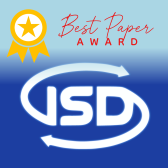Abstract
This paper presents the design of a heritage digital twin of the Serra da Estrela cheesemaking process. The proposed solution integrates traditional knowledge with digital capabilities to ensure the preservation and sustainable practices of this intangible cultural heritage. Design science research is the selected approach to create a digital replica of the cheesemaking process, refined through iterative design and development phases, stakeholder interviews, and field demonstrations. The findings reveal that a heritage digital twin enables (1) memorization of local practices, (2) real-time monitoring and decision support, and (3) audit traces. It upholds traditional methods while enhancing resource efficiency and compliance with health standards. This work pioneers the application of digital twins to the cultural heritage of local food production, adhering to the requirements of protected designation of origin.
Paper Type
Full Paper
DOI
10.62036/ISD.2024.3
A Heritage Digital Twin for Serra Da Estrela Cheese Production
This paper presents the design of a heritage digital twin of the Serra da Estrela cheesemaking process. The proposed solution integrates traditional knowledge with digital capabilities to ensure the preservation and sustainable practices of this intangible cultural heritage. Design science research is the selected approach to create a digital replica of the cheesemaking process, refined through iterative design and development phases, stakeholder interviews, and field demonstrations. The findings reveal that a heritage digital twin enables (1) memorization of local practices, (2) real-time monitoring and decision support, and (3) audit traces. It upholds traditional methods while enhancing resource efficiency and compliance with health standards. This work pioneers the application of digital twins to the cultural heritage of local food production, adhering to the requirements of protected designation of origin.




Recommended Citation
Mendes, I., Monteiro, J. & Barata, J. (2024). A Heritage Digital Twin for Serra Da Estrela Cheese Production. In B. Marcinkowski, A. Przybylek, A. Jarzębowicz, N. Iivari, E. Insfran, M. Lang, H. Linger, & C. Schneider (Eds.), Harnessing Opportunities: Reshaping ISD in the post-COVID-19 and Generative AI Era (ISD2024 Proceedings). Gdańsk, Poland: University of Gdańsk. ISBN: 978-83-972632-0-8. https://doi.org/10.62036/ISD.2024.3